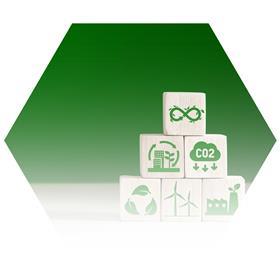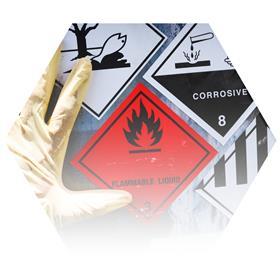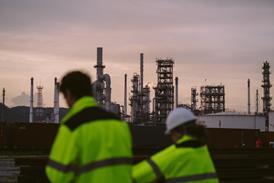Sustainable Growth and Innovation | Low Carbon and Circular Economy | Responsibility and stewardship | People and Community
A snapchat of the UK chemical industry outlining some of the progress, contributions and challenges that lie ahead. The metrics below have been mapped to relevant United Nations Sustainable Development Goals and, where possible, also to corresponding specific SDG targets to demonstrate areas of potential contribution to the Global Goals.
Sustainable Growth and Innovation
SDGs 8- Decent work and economic growth, 12- Responsible consumption and production
R&D Expenditure
SDG target 9.5: Enhance and upgrade industrial technologies.

The UK chemical and pharmaceutical sector is a national leader in terms of R&D spend with an annual investment of over £8 billion which accounts for 17% of the UK’s total business spend and equivalent to 0.4% of national income.
Industry spent a further £6.9 billion in 2022 on business investment into areas such as buildings, vehicles and machinery.
Gross Value Added
SDG target 9.2: Promote inclusive and sustainable industrialisation.

In 2022, chemical industry revenues in the UK stood at £73.7 billion, with a Gross Value Added (GVA) of £28.9 billion up 8.5% from 2019.
The chemical and pharmaceuticals industry is one of the UK’s largest industries and plays a hugely important role in the nation’s economy. The industry also plays a big role in the European chemical market, being one of the countries with the largest chemical revenue in the region.
Productivity
SDG target 8.2: Diversify, innovate and upgrade economic productivity. UN definition: achieve higher levels of economic productivity through diversification, technological upgrading and innovation, including through a focus on high-value added and labour-intensive sectors.

Despite challenges from pandemic related lockdowns, severe trade friction, and soaring raw material prices, UK chemical output increased 5.3% and 3.7% in 2020 and 2021 respectively, with UK chemical production entering 2022 at near record highs. The rest of the year was less positive for the chemical sector: in the last quarter output was 13.0% lower than at the beginning of the year and continued decreasing throughout 2023.
Through the pandemic demand for chemical and pharmaceuticals remained high as companies provided essential products for the medical emergency (medicines, vaccine, hand sanitiser, etc.) and stockpiling before the end of Brexit boosted demand for chemicals.
However, in 2022 the high price of energy resulted in a cost-of-living crisis; which, coupled with a shift in consumer demand towards services over goods, led to a downturn in the industry.
In 2023 with less volatile energy costs and easing of supply chains, cost of production decreased but demand –both from direct consumers and other sectors- remains subdued. In addition to weaking demand and higher costs compared to pre-pandemic, cheaper imports and destocking force UK chemical producers to keep finished prices low.
Low Carbon and Circular Economy
SDGs 7, 8, 12,13
GHG emissions and energy efficiency
SDG target 9.5: enhance and upgrade industrial technologies

Total GHG emissions from the UK chemical industry fell by just over 30% in the decade between 2011 and 2021.
This is particularly significant given that the production output of chemicals and chemical products in the UK has increased by 11.4% from 2018 to Q1 2023.
Looking to the future, ~75% of UK chemical and pharmaceutical direct emissions are covered by public greenhouse gas targets, ~35% of emissions are covered by carbon neutral/positive commitments by 2025/2030/2050, and ~65% of our emissions originate nearby cluster decarbonisation projects.
Waste Recovered
SDG target 12.5: by 2030, substantially reduce waste generation through prevention, reduction, recycling and reuse.

Chemical recycling has grown in efficiency over the past decade, helping to increase recycling rates of plastic packaging; the recovery rate of plastic packaging increased 75% between 2012 and 2021. However, the total amount of plastic packaging waste decreased by only 1.6% in the same period, meaning there is a larger problem related to production and consumption which still requires enormous attention.
Resource efficiency
SDG target 8.4: improve progressively, through 2030, global resource efficiency in consumption and production and endeavour to decouple economic growth from environmental degradation, in accordance with the 10-Year Framework of Programmes on Sustainable Consumption and Production, with developed countries taking the lead.

SDG target 12.3: by 2030, substantially reduce waste generation through prevention, reduction, recycling and reuse
The total waste, both hazardous and non-hazardous, recovered from the chemical sector increased from 19% in 2004 to 35% in 2010 and has further increased 42% in 2021.
However, members have targets to reduce waste through resource efficiency; in 2021, 84% of member sites set at least one target related to resource efficiency. Of these targets, 65% are being met or exceeded. On average, 77% of energy targets are met or exceeded; 57% of water targets; 72% of waste targets, and 53% of raw materials/yields targets.
Responsibility and stewardship
SDGs, 3, 8, 12
Lost time accident rate
SDG target 8.8: protect labour rights and promote safe working environments. UN definition: protect labour rights and promote safe and secure working environments for all workers, including migrant workers, in particular women migrants, and those in precarious employment.

CIA members—supported by Responsible Care—have reduced the rate of lost time accidents by 77% in the period 1992-2021.
This means for every hour worked in 2021, there are 77% fewer lost time accidents than there were in 1992.
Emissions to air
SDG target 3.9: by 2030, substantially reduce the number of deaths and illnesses from hazardous chemicals and air, water and soil pollution and contamination.
SDG target 12.4: by 2030, achieve the environmentally sound management of chemicals and all wastes throughout their life cycle, in accordance with agreed international frameworks and significantly reduce their release to air, water and soil in order to minimise their adverse impacts on human health and the environment.

From 2013-2021 (inclusive) the chemical sector has reduced emissions across the five National Emissions Ceilings (ammonia, nitrogen oxides, sulphur oxides, non-methane volatile organic compounds and particulate matter) by an average of 35%.
This includes reductions of 42% ammonia, 35% nitrogen oxides, 53% sulphur oxides, 24% non-methane volatile organic compounds and 25% particulate matter.
In 2021, total emissions from the chemical sector represented only 1.1% of the UK total for these five substance categories.
Hazardous waste
SDG target 3.9: by 2030, substantially reduce the number of deaths and illnesses from hazardous chemicals and air, water and soil pollution and contamination.

Hazardous waste produced by the chemical sector reduced in mass by 15% from 2013 to 2019. There has then been a further 34% substantial reduction between 2019 and 2021.
Nevertheless, in 2021 360Kt of hazardous waste was produced by the chemical; two thirds of this waste was disposed of whilst one third was recovered.
The average UK health damage cost reductions achieved by cutting emissions of hazardous chemicals to air from 2013 to 2021 is approximately £50 million.
The health damage cost savings by pollutant emitted are as follows: £8.7m for Ammonia; £450k for Non-Methane Volatile Organic Compounds; £28.6m for Nitrogen Oxides; £8.8m for Sulphur Oxides; £4.3m Particulates.
People and Community
SDGs 5, 8, 9
Gender Diversity
SDG target 8.5: full employment and decent work with equal pay.

In 5% of foundation industry businesses, there are no female employees.
Despite chemicals reporting higher female representation than most of the foundation industries—37%, outperforming manufacturing in general by around 13%—across the board, female employees are a minority in the workforce.
In addition, where female employment in the chemical industry does exist, it is almost exclusively concentrated in non-production or support functions compared to manufacturing or technical roles.
Ethnic Diversity
SDG target 9.2: promote inclusive and sustainable industrialisation.

95.5% of workers in the chemical industry are white, with the second most predominant ehtnicity being Asian or Asian British.
Regarding education, 36% of workers have a degree of equivalent—less than 5% have no qualifications.
Employment
SDG target 8.5: full employment and decent work with equal pay.

SDG target 9.2: promote inclusive and sustainable industrialisation.
The UK chemical and pharmaceutical industry directly employs over 149,000 people with two thirds working in the chemical industry and the remaining third in pharmaceuticals.







